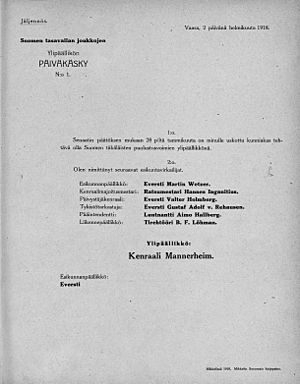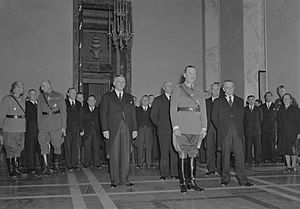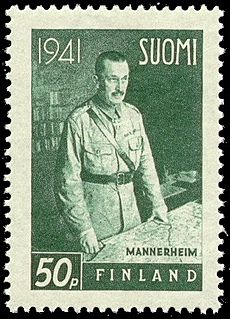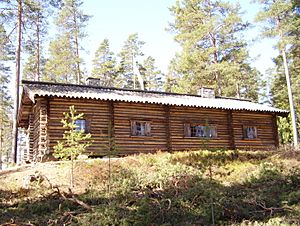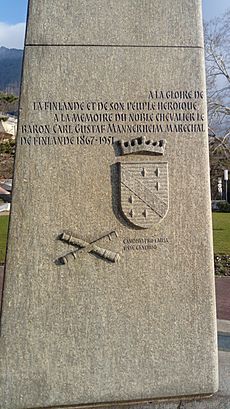Carl Gustaf Emil Mannerheim facts for kids
Quick facts for kids
Carl Gustaf Emil Mannerheim
VR SR, SVR SR ketj., SL SR
|
|
|---|---|

Mannerheim in 1940
|
|
| 6th President of Finland | |
| In office 4 August 1944 – 11 March 1946 |
|
| Prime Minister |
|
| Preceded by | Risto Ryti |
| Succeeded by | Juho Kusti Paasikivi |
| Commander-in-Chief of the Finnish Defence Forces | |
| In office 30 November 1939 – 12 January 1945 |
|
| Preceded by | Hugo Österman (as Commander of the Hosts) Kyösti Kallio (as civilian Commander-in-Chief; relinquished the title to Mannerheim due to war) |
| Succeeded by | Erik Heinrichs (as Chief of Defence) |
| In office 25 January 1918 – 30 May 1918 |
|
| Preceded by | Position established |
| Succeeded by | Karl Fredrik Wilkama |
| State Regent of Finland | |
| In office 12 December 1918 – 26 July 1919 |
|
| Preceded by | Pehr Evind Svinhufvud |
| Succeeded by | Kaarlo Juho Ståhlberg (as President of the Republic) |
| Personal details | |
| Born | 4 June 1867 Louhisaari Manor, Askainen, Grand Duchy of Finland, Russian Empire |
| Died | 27 January 1951 (aged 83) Cantonal Hospital, Lausanne, Switzerland |
| Resting place | Hietaniemi Cemetery, Helsinki, Finland |
| Spouse |
Anastasie Arapova
(div. 1919) |
| Children |
|
| Parents |
|
| Relatives |
|
| Profession | Military officer, statesman |
| Signature | |
| Military service | |
| Allegiance |
|
| Branch/service |
|
| Years of service |
|
| Rank |
|
| Battles/wars |
|
Baron Carl Gustaf Emil Mannerheim (born June 4, 1867 – died January 27, 1951) was a very important Finnish military leader and statesman. He played a huge role in Finland's history. He was the military leader of the "Whites" during the Finnish Civil War in 1918. He also served as the Regent of Finland from 1918 to 1919.
Later, he became the commander-in-chief of Finland's armed forces during World War II (1939–1945). Finally, he was the sixth president of Finland from 1944 to 1946. He is the only person to have held the title of Marshal of Finland, which he received in 1942.
Before Finland became independent, it was part of the Russian Empire. Mannerheim started his career in the Imperial Russian Army. He fought in the Russo-Japanese War and World War I. By 1917, he had become a lieutenant general. He even met Emperor Nicholas II of Russia several times.
After the October Revolution in Russia in 1917, Finland declared its independence on December 6, 1917. Soon after, Finland had its own Finnish Civil War in 1918. This war was between the pro-Bolshevik "Reds" and the "Whites," who were supported by the Finnish government and German troops.
Mannerheim was chosen to lead the White forces in January 1918. He led them to victory and held a big parade in Helsinki in May. After the war, he became the Regent of Finland from December 1918 to July 1919. He ran for president in 1919 but lost. He then focused on other important work, like helping to start the Mannerheim League for Child Welfare in 1920 and leading the Finnish Red Cross from 1922.
In 1931, Mannerheim became Chairman of the Finnish Defence Council. When the Soviet Union attacked Finland in November 1939, starting the Winter War, Mannerheim became the commander-in-chief of Finland's armed forces. He also led Finnish forces alongside Nazi Germany in the Continuation War (1941–1944) against the Soviet Union.
In 1944, as World War II was ending, the Finnish Parliament made Mannerheim President of Finland. He then worked to make peace with the Soviet Union and the UK. He stepped down as president in 1946 and passed away in 1951.
Many Finns consider Mannerheim the greatest Finn ever. He is often called the father of modern Finland because of his key role in gaining and keeping Finland's independence. However, his actions during the Civil War and his cooperation with Nazi Germany are still debated by some historians.
Early Life and Military Career
Family Background and Childhood
The Mannerheim family originally came from Germany. They became Swedish noblemen in 1693. Later, in the 1700s, they moved to Finland, which was then part of Sweden. After Russia took Finland in 1809, Mannerheim's great-grandfather, Count Carl Erik Mannerheim, became an important leader in the new Finnish government. His grandfather, Count Carl Gustaf Mannerheim, was a scientist who studied insects.
Carl Gustaf Emil Mannerheim was born on June 4, 1867, in Louhisaari Manor. When he was 13, his father left the family. His mother died the next year. His uncle, Albert von Julin, then became his guardian and helped pay for his education. As the third child, Mannerheim inherited the title of Baron.
Education and Early Military Service
In 1882, Mannerheim went to the Hamina Cadet School, a military school for noble families in Finland. He was a tall young man, standing 6 feet 4 inches (1.93 meters) tall. He was expelled in 1886 for leaving without permission. He then went to a private school in Helsinki and passed his university entrance exams in 1887.
From 1887 to 1889, Mannerheim studied at the Nicholas Cavalry College in St. Petersburg, Russia. In 1891, he joined the Chevalier Guard Regiment in St Petersburg. In 1892, he married Anastasia Arapova, a wealthy noblewoman. They had two daughters, Anastasie and Sofia. They separated in 1902 and divorced in 1919.
Mannerheim served in the Imperial Chevalier Guard until 1904. He was an excellent horse rider and was in charge of buying horses for the army. In 1896, he took part in the coronation of Emperor Nicholas II, which he remembered as a very grand event.
Language Skills
Mannerheim's first language was Swedish. He also spoke German, French, and Russian very well. He learned Russian while serving in the Russian Imperial Army. He also knew some English, Polish, Portuguese, Latin, and Chinese. He only started learning Finnish properly after Finland became independent.
Service in the Russian Army
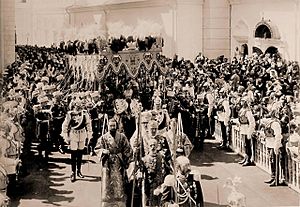
In 1904, Mannerheim volunteered to fight in the Russo-Japanese War. He was sent to Manchuria as a Lieutenant-Colonel. He showed bravery in battle and was promoted to Colonel in 1905 after the Battle of Mukden.
After the war, in 1906, Mannerheim went on a secret mission for the Russian General Staff. He traveled through Russian Turkestan to Beijing, China. He was disguised as a collector of cultural items. He wanted to gather information about China's military and reforms. He traveled with a small group, including a Cossack guide and a Chinese interpreter.
During his journey, he explored different regions and met the 13th Dalai Lama in Tibet. He even showed the Dalai Lama how to use a pistol! He arrived in Beijing in July 1908 and returned to St. Petersburg. His journey gave Russia important information about China. This trip also made him love Asian art, which he collected for the rest of his life.
After returning in 1909, Mannerheim was given command of a cavalry regiment in Poland. The next year, he was promoted to major general. He became part of the Emperor's personal staff and commanded a cavalry brigade.
When World War I began, Mannerheim fought on the Eastern Front. He was recognized for his bravery in December 1914 and received the Order of St. George. In 1915, he was given command of the 12th Cavalry Division.
In early 1917, Mannerheim visited Finland and St. Petersburg and saw the start of the February Revolution in Russia. He was promoted to lieutenant general in April 1917. However, the new Russian government didn't trust him, so he was removed from his duties. He decided to retire and returned to Finland. Mannerheim always kept a portrait of Emperor Nicholas II in his home, saying, "He was my emperor."
Political Career
Leading the Whites and Becoming Regent
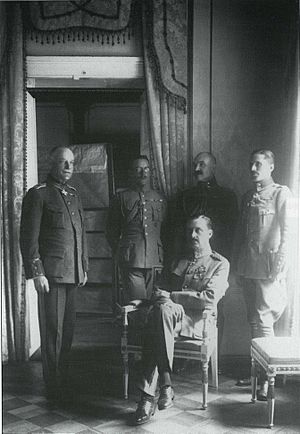
In December 1917, Finland declared independence from Russia. In January 1918, Mannerheim was appointed to lead the Finnish army, which was mostly made up of local White Guards. He had only 24,000 mostly untrained soldiers. The Finnish "Red Guard," supported by Soviet Russia, had more troops.
Mannerheim's army needed weapons. He marched his men to Vaasa, where 42,500 Russian soldiers were stationed. He surrounded them, making it look like his entire army was armed, even though only the front row had weapons. The Russians surrendered, giving the Whites much-needed arms. Germany also sold weapons to Finland. Many Swedish officers and Finnish officers trained by Germans also helped the Whites. In March 1918, German troops landed in Finland and helped capture Helsinki.
After the Whites won the Finnish Civil War, Mannerheim resigned as commander-in-chief. He left Finland in June 1918. While abroad, he spoke with Allied diplomats, explaining his concerns about the Finnish government's close ties to Germany. At the time, Finland was considering having a German prince as its king.
In October 1918, the Finnish government sent Mannerheim to Britain and France to get them to recognize Finland's independence. In December, he was called back to Finland. The German prince had given up the idea of being king, and Mannerheim was chosen as Regent. As Regent, he often used the Finnish form of his name, Kustaa, to show his connection to Finland.
Mannerheim successfully got Britain and the United States to recognize Finland's independence. In July 1919, after a new republican constitution was approved, Mannerheim ran in the first presidential election. He lost to Kaarlo Juho Ståhlberg and then stepped away from public life.
Between the Wars

For many years, Mannerheim did not hold a public office. Some politicians saw him as a controversial figure because of his role in the Civil War. They worried he wanted Finland to join the "Whites" in the Russian Civil War. Socialists also saw him as the "White General" who fought against them. Mannerheim himself believed that politicians often put their party's interests before the country's.
However, he stayed busy. He led the Finnish Red Cross from 1919 to 1951. He also founded the Mannerheim League for Child Welfare, an organization that helps children. He was also involved in banking and was a board member of Nokia Corporation.
In the 1920s and 1930s, Mannerheim traveled and hunted a lot in Asia. He visited places like India, Burma, Sikkim, and Nepal. He even went on a tiger hunt in Nepal.
In 1929, Mannerheim refused an offer from some right-wing groups to become a military dictator. He did support the right-wing Lapua Movement to some extent. In 1931, President Pehr Evind Svinhufvud appointed Mannerheim as chairman of Finland's Defence Council. He also promised Mannerheim that he would become the Commander-in-Chief of the Finnish Army if there was a war. This promise was renewed by the next president, Kyösti Kallio, in 1937.
In 1933, Mannerheim received the rank of Field Marshal. Over time, people began to see him less as a "White General" and more as a national hero. He encouraged everyone to unite and focus on defending Finland. He said, "we need not ask where a man stood fifteen years ago." Mannerheim tried to improve Finland's military, but it wasn't as fast as he hoped. He often disagreed with the government about military spending.
Assassination Attempt in 1920
After the Civil War, some "Reds" were very angry about their defeat. One person, Eino Rahja, planned to assassinate Mannerheim in April 1920 during a parade in Tampere. However, the person chosen to shoot Mannerheim hesitated, and the attempt failed. Other attempts were also unsuccessful because the authorities received tips. The people involved were later arrested.
Commander-in-Chief During World War II

In 1939, talks between Finland and the Soviet Union failed. Mannerheim knew war was coming and was worried about the army's lack of equipment. He resigned from the military council on October 17, 1939, saying he would only return as Commander-in-Chief. When the Soviet Union attacked Finland on November 30, 1939, starting the Winter War, Mannerheim, at 72 years old, officially became the supreme commander of the Finnish armies.
The defensive lines built by Finland became known as the Mannerheim Line. Mannerheim set up his headquarters in Mikkeli. He often visited the front lines to encourage his soldiers. He was very good at keeping up the fighting spirit of the troops.
Mannerheim tried to keep his relationship with Adolf Hitler's government formal. He didn't really admire Hitler, even though he was initially interested in his rise to power. Before the Continuation War, the Germans offered Mannerheim command of 80,000 German troops in Finland. Mannerheim refused because he didn't want to tie Finland too closely to Nazi Germany's war goals. He was willing to cooperate with Germany for practical reasons, mainly because of the threat from the Soviet Union. In July 1941, Finnish troops, with German help, recaptured territories lost to the Soviet Union in the Winter War. They also advanced into East Karelia. Finnish troops took part in the Siege of Leningrad, which lasted for a very long time.
Hitler's Visit to Mannerheim
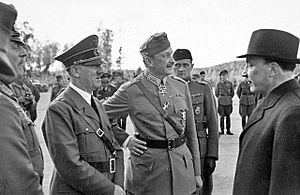
Mannerheim's 75th birthday on June 4, 1942, was a national celebration. The government gave him the special title of Marshal of Finland. He is the only person to ever receive this title. On his birthday, Hitler made a surprise visit to Finland. Mannerheim didn't want to meet Hitler in Helsinki or at his headquarters, so they met secretly near Imatra.
Hitler, along with President Ryti, met Mannerheim at a railway siding. They had a birthday meal and discussed things. Hitler spent about five hours in Finland. He reportedly asked Finland to increase its military actions against the Soviets, but he didn't make any specific demands.
During the visit, a Finnish engineer secretly recorded the first eleven minutes of Hitler's and Mannerheim's private conversation. This was very unusual because Hitler never allowed secret recordings. The engineer managed to place a microphone near them. After eleven minutes, Hitler's bodyguards noticed the microphone and stopped the recording. The tape was kept secret for many years but was later released to the public. It is the only known recording of Hitler speaking informally.
There's a story that during their conversation, Mannerheim lit a cigar. This was surprising because Hitler was known to dislike smoking. But Hitler continued the conversation calmly. This showed Mannerheim that Hitler was not in a strong position and couldn't order him around. Mannerheim later visited Hitler's headquarters in East Prussia.
End of War and Presidency
In June 1944, to ensure Germany's support during a major Soviet attack, Mannerheim felt it was necessary to agree to a pact demanded by the German Foreign Minister. However, Mannerheim made sure that President Risto Ryti signed it, not him. This was known as the Ryti-Ribbentrop Agreement. This allowed Mannerheim to cancel the agreement when President Ryti resigned in August 1944. Mannerheim then became president.
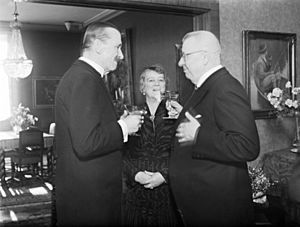
A month after Mannerheim became president, the Continuation War ended. Finland had to accept harsh peace terms, but they were much better than what other countries bordering the Soviet Union faced. Finland kept its independence, its democracy, and its market economy. However, it lost a lot of land, including parts of Karelia and all of Petsamo. Many refugees from Karelia needed new homes. Finland also had to pay a lot in war reparations.
Finland also had to fight the Lapland War against German troops who were retreating from northern Finland. At the same time, Finland had to reduce the size of its own army. Mannerheim appointed Lieutenant General Hjalmar Siilasvuo to lead the fight against the Germans. Many people agree that only Mannerheim could have guided Finland through these difficult times. He helped the Finnish people accept the peace terms and rebuild the country after the war.
Mannerheim's time as president was hard. He was 77 years old in 1944 and had only accepted the job because he was asked to. He was often sick, and he had to deal with the demands of the Allied Control Commission. He was worried that he might be put on trial for war crimes, but this never happened. One reason was that Joseph Stalin, the leader of the Soviet Union, respected Mannerheim. Stalin even told a Finnish group in 1947 that Finland owed a lot to their old Marshal. Thanks to Mannerheim, Finland was not occupied by the Soviets.
Mannerheim worked hard to fulfill Finland's peace obligations. He also stressed the importance of rebuilding Finland after the war. He had health problems in 1945 and took medical leave. He spent six weeks in Portugal to get better. After the war crimes trials ended in February 1946, Mannerheim decided to resign. He felt he had completed his duties: the war was over, peace terms were met, and the trials were done.
Mannerheim resigned as president on March 11, 1946. He said his health was declining and his tasks were finished. He was replaced by J. K. Paasikivi.
Later Life and Legacy
Final Days and Passing
After resigning, Marshal Baron Mannerheim bought a manor in Lohja, Finland, to enjoy his retirement. However, he had many health problems. In 1947, he was advised to go to a sanatorium in Montreux, Switzerland, to recover and write his memoirs. Valmont became his main home for the rest of his life, though he often visited Finland and other countries.
Because he was old and sick, Mannerheim only wrote some parts of his memoirs himself. Other parts were dictated or written by his assistants based on his memories. He mostly wrote about Finland's history, especially from 1917 to 1944. He didn't write much about his private life. Mannerheim died on January 27, 1951, in a hospital in Lausanne, Switzerland. His memoirs were published after his death. He was buried on February 4, 1951, in Hietaniemi Cemetery in Helsinki with full military honors.
Mannerheim's Enduring Legacy
Today, Mannerheim is still highly respected as Finland's greatest statesman. People admire him because he avoided party politics and always seemed to serve his country without selfish reasons. He was brave, visiting the front lines during wars, and worked hard even when he was old. He also had great foresight in preparing Finland for a possible Soviet invasion years before it happened.
Even though Finland fought alongside Nazi Germany during the Continuation War, many leaders of the Allies respected Mannerheim. For example, Winston Churchill, the British Prime Minister, found it difficult to declare war on Finland because of his previous good relationship with Mannerheim. They even exchanged polite letters showing their mutual respect.
Mannerheim's birthday, June 4, is celebrated as Flag Day by the Finnish Defence Forces. This was decided in 1942, when he also received the title of Marshal of Finland. On Flag Day, there is a national parade, and military members receive awards and promotions.
Mannerheim's life is remembered in the Mannerheim Museum in Helsinki. The most famous street in Helsinki, Mannerheimintie (Mannerheim Road), was named after him during his lifetime. The Marshal's Cabin, his former hunting lodge, is now a museum and restaurant in Loppi, Finland.
Many statues and landmarks across Finland honor Mannerheim. The most famous is the Equestrian statue of Marshal Mannerheim in Helsinki. There are also statues in Turku, Seinäjoki, Mikkeli, and Lahti. In 2004, Mannerheim was voted the greatest Finnish person of all time in a national survey.
Finland has issued many postage stamps in his honor. In 1960, the United States even honored Mannerheim as the "Liberator of Finland" on a stamp. Mannerheim has also been portrayed in plays and films, showing his lasting impact on Finnish culture.
Military Ranks
Ranks Held
In the Russian Army
- 1888: Non-commissioned officer
- 1889: Cornet
- 1891: Cornet of the Guard
- 1893: Lieutenant of the Guard
- 1902: Captain of the Guard
- 1904: Lieutenant Colonel
- 1905: Colonel
- 1911: Major General
- 1917: Lieutenant General
In the Finnish Army
- 1918: General of Cavalry
- 1933: Field Marshal
- 1942: Marshal of Finland
Supreme Command Positions
- 1918: Commander-in-Chief of the White Guard: January to May 1918
- 1918: Commander-in-Chief of the Finnish Defence Forces: December 1918 to July 1919
- 1931: Chairman of the Defence Council: 1931 to 1939
- 1939: Commander-in-Chief of the Finnish Defence Forces: 1939 to 1946
Awards and Honors
| Coat of Arms of Carl Gustaf Emil Mannerheim | |
|---|---|
 |
|
| Armiger | Carl Gustaf Emil Mannerheim |
| Motto | "Candida pro causa ense candido"("With an honourable sword for an honourable cause") |
Mannerheim received 82 military and civilian awards during his life.
Finland
 Grand Cross with Swords and Diamonds of the Order of the Cross of Liberty (1940)
Grand Cross with Swords and Diamonds of the Order of the Cross of Liberty (1940) Knight of the Mannerheim Cross, 1st and 2nd class (1941)
Knight of the Mannerheim Cross, 1st and 2nd class (1941) Grand Cross with Collar, Swords and Diamonds, of the Order of the White Rose (1944)
Grand Cross with Collar, Swords and Diamonds, of the Order of the White Rose (1944) Grand Cross with Swords of the Order of the Lion of Finland (1944)
Grand Cross with Swords of the Order of the Lion of Finland (1944)
Russian Empire
 Order of St. Anna, 2nd degree (1906)
Order of St. Anna, 2nd degree (1906) Order of St. Stanislaus, 2nd class (1906)
Order of St. Stanislaus, 2nd class (1906) Order of St. Vladimir, 4th degree (1906)
Order of St. Vladimir, 4th degree (1906) Order of St. George, Knight 4th class (1914)
Order of St. George, Knight 4th class (1914)
Sweden
 Knight of the Royal Order of the Seraphim (1919)
Knight of the Royal Order of the Seraphim (1919) Knight Grand Cross 1st Class of the Order of the Sword (1942)
Knight Grand Cross 1st Class of the Order of the Sword (1942)
Other Countries
 Denmark: Knight of the Order of the Elephant (1919)
Denmark: Knight of the Order of the Elephant (1919) France: Grand Cross of the Legion of Honour (1939)
France: Grand Cross of the Legion of Honour (1939) Estonia: Military Order of the Cross of the Eagle, 1st Class with Swords (1930)
Estonia: Military Order of the Cross of the Eagle, 1st Class with Swords (1930) German Empire: Iron Cross 1st and 2nd Class (1918)
German Empire: Iron Cross 1st and 2nd Class (1918) Nazi Germany: Golden Grand Cross of the Order of the German Eagle
Nazi Germany: Golden Grand Cross of the Order of the German Eagle Nazi Germany: Knight's Cross of the Iron Cross with Oak Leaves (1944)
Nazi Germany: Knight's Cross of the Iron Cross with Oak Leaves (1944) United Kingdom: Knight Grand Cross of the Order of the British Empire (GBE) (1938)
United Kingdom: Knight Grand Cross of the Order of the British Empire (GBE) (1938)
Works
- C.G. Mannerheim, Across Asia From West to East in 1906–1908. (1969) Anthropological Publications. Oosterhout N.B. – The Netherlands
- Across Asia : Vol. 1 – digital images
See also
 In Spanish: Carl Gustaf Emil Mannerheim para niños
In Spanish: Carl Gustaf Emil Mannerheim para niños
- Mannerheim Cross
- Mannerheim Line
- Mannerheim Museum
- Mannerheim Park
- Mannerheimintie
- Marshal's Cabin
Images for kids




